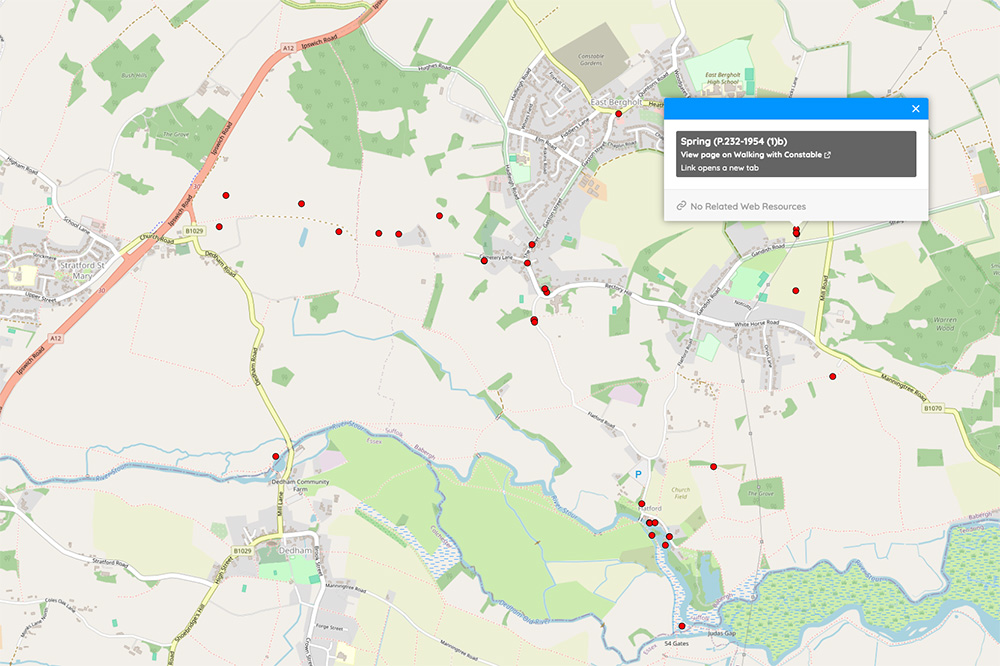Playing Peripleo
by Andy Corrigan
During the IIIF’s 2023 Online Meeting, one of the lightening talks delivered by Gethin Rees from the British Library was on the topic of ‘Presenting Recogito IIIF Annotations using Peripleo’. Peripleo, a browser-based visualisation tool for mapping things to places, that was originally built as part of the Pelagios Network and has been developed for the AHRC funded Towards a National Collection ‘Locating a National Collection’ foundation project.
Whilst I’m not likely to be attempting to locate huge national collections any time soon, the tool none-the-less presents a viable opportunity to explore the possibilities of being able to present smaller scale projects in exciting, and importantly, linked, ways. With reuse, cost, simplicity and sustainability in mind, the tool makes the most of the tools that Github offers - handy that I’ve been growing in confidence with using Github then!
I was also intrigued and excited by the possibility of being able to put IIIF to work in the process. Although Cambridge Digital Library implemented IIIF a few years ago now, it has taken a while for some of the tools it facilitates to progress from things you need a developer for to things you can do yourself, and that stage seems to be coming of age now, which is really exciting, because it means we can start showing people what they can do with all that fantastic content.
So I eagerly signed up for the workshop event that Gethin and the team at the British Library had planned on the 11th/12th December 2023!
It’s taken a while to get around to writing this up because I wanted to find some more time to have a better play around with what I could achieve and hoped to be able to present a super-flashy result. As it is, I’ve been wrangling JSON for a couple of days now and reached the conclusion that I could perhaps do with stepping back and trying to understand the format a bit more … which is a polite way of saying that I’m tearing my hair out in frustration at my apparent inability to balance validity with something that actually functions.
Although it’s perhaps been a while, I’m pretty used to this sensation, so am not too perturbed and still feeling pretty determined. I’ve always had a difficult relationship with code, and that’s something I’ve learnt to embrace rather than fear:
I know it’s possible. I know I can do it. I’m pretty sure when I do, it will look super-flashy, and I’ll be pleased as punch. Not least because I know that it will be a rewarding journey learning.
In the meantime, I thought I’d revert to presenting what I managed to achieve after that initial workshop, which to be fair, I was still pretty chuffed with!
This map visualises and links out to some of the content I have been working with on the Walking with Constable project. The project has generated a variety of digital media and other outputs, so I thought it would make an excellent test dataset for seeing what I could do with Peripleo.
Over the last few days, I’ve been attempting to incorporate IIIF images, and I’ve also experimenting with different ways of presenting the data. One idea is to see how it works presenting multiple digital objects linked to single points, so to link all the different digital objects to single locations at which they are relevant.
The other thing I want to explore is Peripleo’s ‘type’ functionality, which I think I could use to visualise the locations of the different media outputs the project has been working with or generating. This would allow me to filter objects by media type, such as aerial photo, print, painting, sketch, manuscript, audio files, object/artefacts and various other participant generated content.
The last couple of days haven’t been wasted though. I have had some success with incorporating IIIF images into the visualisation, but I want to push that a bit further before I’m happy/confidant with it and thought it might actually be useful to write up further posts as I develop my skills and ideas.
In the meantime though I really think that despite my ineptitude with JSON, more of a hurdle than a barrier, that being able to use, share, and in time show others how to use a tool such as Peripleo is incredibly impactful in its potential. I think it will be of great use in current and future projects I’m working on, and also in my journey as I progress my AHRC-RLUK Professional Practice Fellowship. I don’t think I’d have been bold enough to have attempted this had it not been for the workshop I attended, so utmost thanks to Gethin and the team at the British Library!
